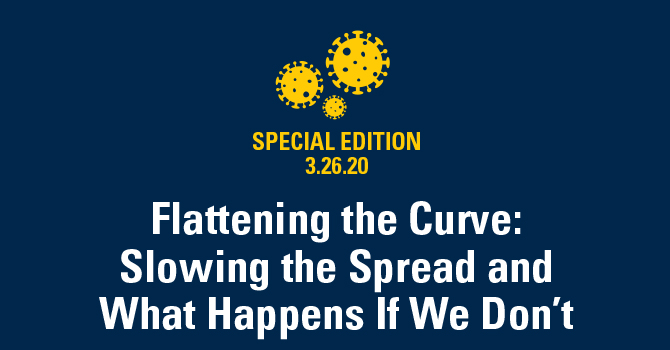Flattening the Curve: Slowing the Spread and What Happens If We Don’t

In just a few weeks, our lifestyles have changed dramatically because of the coronavirus. What does it mean to "flatten the curve" of infections, and what will it look like if we don't? On this special edition of Population Healthy, preventive medicine expert and clinical assistant professor of Epidemiology Laura Power shares perspectives from the fields of public health and preventive medicine and what hospitals are dealing with right now.
|
Subscribe and listen to Population Healthy on Apple Podcasts, Spotify, Google Podcasts, iHeartRadio, YouTube or wherever you listen to podcasts! Be sure to follow us at @umichsph on Twitter, Instagram, and Facebook so you can share your perspectives on the issues we discussed, learn more from Michigan Public Health experts, and share episodes of the podcast with your friends on social media. |
Speaker 1: In just a few weeks, our lifestyles have changed dramatically because of the coronavirus. One of the shared battle cries against this invisible enemy is “flatten the curve”. The curve we’re talking about is the number of infections over time. The more infections in a short amount of time, the more vertical the curve looks. But if the number of infections is spread out over a long amount of time the curve flattens out.
Hello and welcome to Population Healthy, a podcast from the University of Michigan School of Public Health,. This episode is part of a series of special editions of our Podcast, focusing on the ongoing coronavirus pandemic. To understand why flatten in the curve is vital to our health care workers, we asked Dr. Laura Power, Clinical Assistant Professor of Epidemiology at the University of Michigan School of Public Health, for some perspectives from the fields of public health and preventative medicine.
Power: Flattening the curve is something we're all hearing about now. And what it really means is to try to decrease the impact that this infection is having on our society, spreading it out over time and even decreasing the number of infections. So one big concern right now is the impact that this will have on our healthcare system, that our hospitals would be overwhelmed. And so to try to decrease that we're hoping to spread out the disease and also decrease the number of people that get sick. At this point, it doesn't seem like we can stop the virus in its tracks at the moment, so we have to at least slow it down. And we can do that by social distancing. The more we keep people away from bigger groups of people, we can solve the spread of infection. If we don't flatten the curve, there's a big concern that we'll have a huge surge of sick people coming to the hospitals. So there could be a big spike of people coming in, who are ill, who are requiring intensive care, even people dying. We wanna make sure that our health care systems can handle the patients that we’ll be seeing and make sure people get the best care. So we want to slow down that amount of people coming to the hospital and make it so we can manage it a little bit better.
Speaker 1: Each day seems to bring about new updates on fears of supply shortages at hospitals around the United States. So we asked Dr. Power what it's like on the ground as providers treat coronavirus patients and anticipate an increasing influx.
Power: Many of our healthcare systems do have patients with COVID-19, so they're going through all the infection prevention protocols, making sure that the healthcare workers are protected, thinking about supplies so that people have the personal protective equipment like mass and shield to protect their eyes, thinking about who needs to get tested as testing availability improves over time, how do they handle all the testing, what's the best way to treat people. There's not a lot of information right now on the best treatment. So there are clinical trials going on, but a lot of things are changing and happening fast to figure out how is the best way to treat people. And even thinking about how to handle the people who maybe aren't sick enough to be in the hospital but maybe we'll have an infection - how to help them manage their disease at home. And then also addressing the worried well. People who are maybe not sick, but they're still wanting to know what do they need to do. Do they have the disease? And helping healthcare providers decide who needs to be tested. As testing starts to become more available, healthcare providers may feel pressured that they need to test everybody, and trying to figure out who really should be tested.
We take care of people who have contagious diseases every day and ideally we have in place protocols that help us be prepared for anything because, when somebody's coming in to a hospital, you don't necessarily know what disease they have, and you don't know if it's contagious or not. So you use sometimes certain symptoms that people have, or certain complaints that help you think “Could this be an infectious disease that I need to worry about being transmitted to other people?”.
So based on that, then you can make decisions about what infection prevention protocols you use like putting people in what we call isolation, like a droplet isolation or an air board isolation or contact isolation. Those different protocols like using different types of masks and eye protection and gowns. So those are the types of things that people can use. There are standard precautions that we use for everybody because you just don't know necessarily what infection somebody may or may not have and then there's transmission based precautions, so based on types of symptoms that people may have. And then we can figure out more as we get lab tests to help us understand what's going on.
Definitely thinking about the personnel, the structure, guidelines that are given out to people, how to triage things, algorithms like that, and then definitely supplies.
There's always planning ahead of time trying to think about supplies. Preparedness planning is always in place but then when it actually happens, it can be very challenging. So the people who are in charge of supplies right now, they're probably working with all their different vendors, the government as well or local health departments, state health department, our federal government and the Strategic National Stockpile. Or there are some supplies that think some of them have been opened. People get creative, and how they can try to find what they need.
Speaker 1: This has been a special edition of Population Healthy, a podcast from the University of Michigan School of Public Health. During the ongoing coronavirus pandemic, we’ll work to bring you analysis from our community of experts to help you understand what this public health crisis means for you. To stay up-to-date in between special edition episodes, be sure to check out our website publichealth.umich.edu, subscribe to our Population Healthy newsletter at publichealth.umich.edu/news/newsletter and follow us on Twitter, Instagram, and Facebook @umichsph.
In This Episode
 Laura Power
Laura Power
Clinical Assistant Professor of Epidemiology, University of Michigan School of Public Health and Clinical Assistant Professor of Internal Medicine at the University of Michigan Medical School
Laura Power’s research interests include vaccine-preventable diseases, communicable diseases epidemiology, infection prevention, and public health. Prior to joining the University of Michigan, Power practiced at Henry Ford Health System in Michigan as an infectious diseases physician, where she also served as the medical director for Infection Prevention. Learn more.
